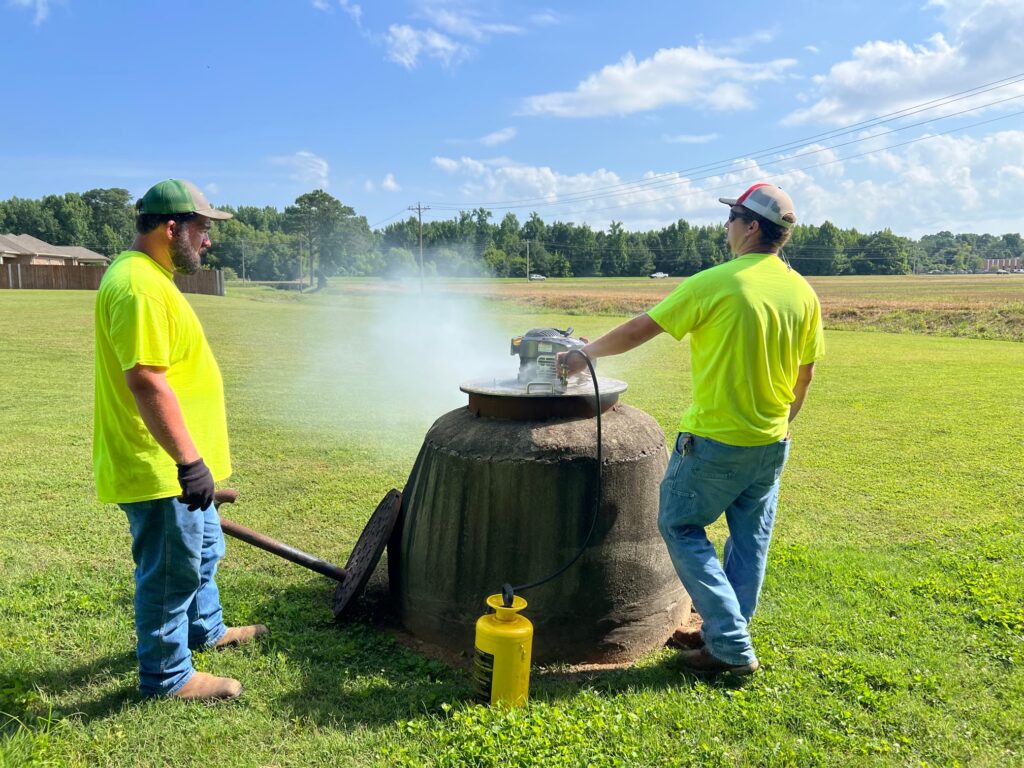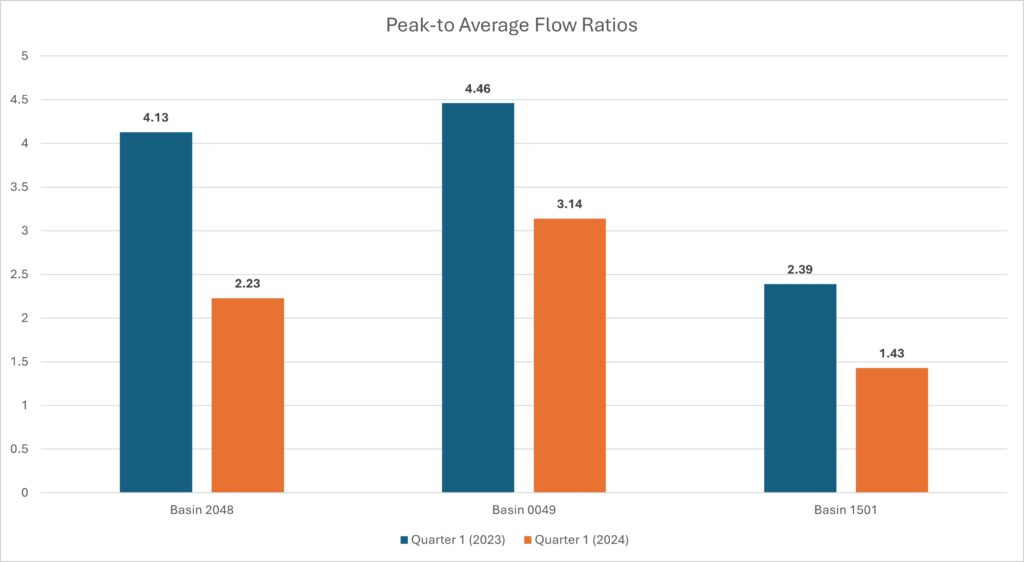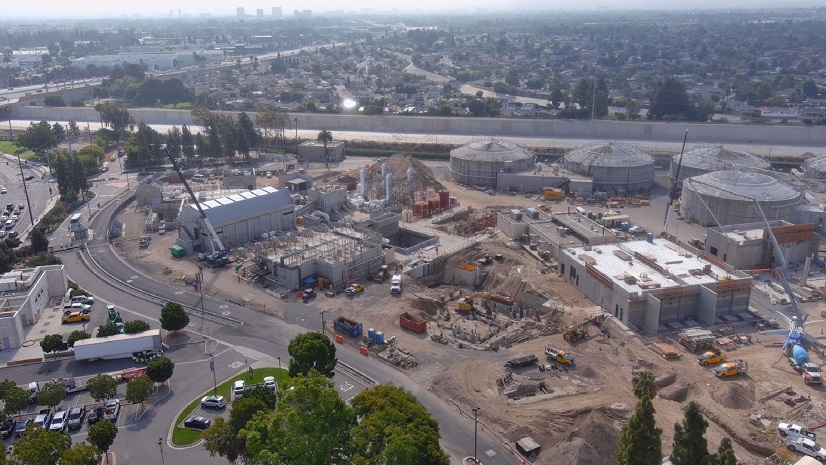By: Marc Courville, GISP, Strategic Asset Management, Athens Utilities
The water and sewer utilities are combined under the Water and Sewer Department of the City of Athens, Alabama. Athens has a population of just over 30,000 residents. Primarily a bedroom community, the city is experiencing a dramatic paradigm shift as it has moved from a small community with slow growth of just over one percent annually to a growth rate of approximately 7.1 percent annually over the last three years. The Water and Sewer Department manages the water treatment, water distribution, wastewater treatment, and wastewater collections. The water and sewer service areas are comprised mostly of the city. The Water and Sewer Department serves 13,750 water and over 9,600 sewer customers. The collection system includes over 204 miles of gravity mains, 4,246 maintenance holes, and 24 lift stations.
Founded in 1818, the city of Athens is older than the state itself. In addition to aging infrastructure, Athens is currently the fastest growing city in the state. The growth combined with sewer inflow and infiltration (I&I) greatly impacts the capacity and processes at the wastewater treatment plant (WWTP). The Water and Sewer Department is taking a cutting-edge approach using GIS technology to manage these challenges.
Population Growth Challenges an Aging System
Growth
Due to the growth and expansion of manufacturing, technology industries, FBI facilities, and the military contracting industry, most of the areas around Huntsville, Alabama, have experienced significant growth in the last few years. Once seen as a pass-through town on Interstate 65 in north Alabama, Athens has become one of the more desirable locations for people to live and sleep, which has led to the city’s tremendous residential growth.
In 2024, the city experienced an increase of over eight percent in population. The 2020 Census population for the city was 25,406 and the number increased to 29,649 (16.7 percent) by the end of 2023. Monte Carlo projections have indicated that these numbers could increase to 37,840 by 2028 and 43,799 by 2033. When Water and Sewer Department director Jimmy Junkin was hired in 2019, the system had 12 sewer lift stations, and now, the department has 25 active stations, with two more in the construction or design phase. Typically, growth is a welcomed challenge for utilities, however, competent infrastructure planning and finding solutions to resolve existing aging system issues is more vital than ever.
“Athens has moved from almost all reactive maintenance to full assessment mode in the water distribution and sewer collection systems in just two years. The assessment efforts ongoing are generating data to solve current problems such as groundwater infiltration and rainwater inflow into the collection system as well, performing critical preventive maintenance on fire hydrants and distribution system isolation valves all in a very systematic manner. Condition assessments of lines and process treatment equipment are the basis for prioritizing capital reinvestment, improving service, and are the basis for the critical assets program. The GIS is key in growth planning as it facilitates hydraulic modeling essential for locating and connecting capacity demand to assets. These programs are critical overall in any utility but are especially critical for Athens as the City experiences seven percent (7%) growth year in and year out.” – Jimmy Junkin, Director Athens Utilities Water and Sewer Department
Aging Infrastructure
The entirety of the 204 miles of sewer flows to one wastewater treatment facility located on Town Creek, which directly flows into Swan Creek. Swan Creek terminates about eight miles south of the treatment facility into the Tennessee River. The facility went through a significant upgrade in 2008 that essentially rebuilt the plant in its entirety. The current capacity is designed for nine MGD with an average flow of around 6.5 MGD. Of this, about 2.5 MGD is actual wastewater from customers. The balance is rainwater inflow and groundwater infiltration (I&I). During significant rain events, the flow occasionally spikes around 300 percent, although there have been a couple instances on record of flow rising over 400 percent. The larger component of the I&I is about 60 percent rainwater derived I&I (RDII). The challenge and duty of the department is to resolve these issues with minimal capital costs and reduce the burden on ratepayers.
Data and Analytics Lead to Better Understanding and Strategic Initiatives
Asset Management Division
In July 2022, Water and Sewer Department director Jimmy Junkin developed the Logistic and Strategic Asset Management (LSAM) division within the water services department to acquire and analyze data, which would assist in resolving the current and arising issues. This would be done using data derived from several different tools, including but not limited to, an enterprise asset management (EAM) system (NEXGEN AM), ArcGIS Pro, and CCTV inspection software (ITpipes).
Within six months, the department was fully staffed, including a manager, assistant manager, and asset management system coordinator. Within one year, all the software was fully implemented, and the department was acquiring the necessary data to understand the array of issues the department was facing. Interns were used to shore up data gaps in the GIS and update inventories in the asset management system (AMS).
From the beginning, the LSAM division made the decision to be completely web-based. This made the workflow of separate databases and software communication more reciprocal and seamless. The team tasked themselves with making operational data more accessible and reliable while also simplifying the processes of entering and tracking that information.
Esri applications, such as ArcGIS Online, ArcGIS Field Maps, Field Maps Designer, and ArcGIS Experience Builder, were critical in the overall success of the data-driven management goals of the department. Once the GIS database became reliable, the team deployed web maps from ArcGIS Pro and dashboards that presented critical information to supervision and management. The dashboards were a critical tool for their ability to present snapshots of important operational data while also having the ability to provide granular information. They also proved to be fundamental in the remediation of I&I issues.
Sewer Model
The department completed an update of the sewer model in 2022 to determine future infrastructure needs for both the growth and I&I impacts during rain events. Recent growth has made it paramount that the system be able to handle these expected loads. The model is driven by GIS data and updated as new infrastructure comes online. This ensures the system can provide the capacity needed when additional development loading is proposed. The model also identifies areas that are at risk of overflow or failure, helping prioritize maintenance and improvements. GIS database maintenance is important to the model’s reliability to determine watershed areas, drainage patterns, and land use. Reliable GIS data is vital to perform accurate simulations and analyses. The GIS provides powerful visualization tools to create maps and models that illustrate sewer flow, overflow locations in the wastewater collection system, and system rehabilitation needs, making it easier for stakeholders to understand complex data.
Flow Monitoring
The I&I issues were addressed in separate steps. Initially, a wastewater collection system flow monitoring study was conducted in the winter and spring of 2020. The study indicated significant I&I issues in most of the collection system. Influent flowrate surges at the wastewater treatment plant (WWTP) during rain events have created and continues to create operational issues.
Twelve permanent flow monitors were installed throughout the city in 2021, covering 72 percent of the entire collection system. These monitors were installed in areas that had aging infrastructure and received the most reactive work orders for repairs and performance. These areas included several historic districts throughout the city, underdeveloped communities, and areas where there is an abundance of vitrified clay sewer pipes. The department developed plans to assess the system in more detail, including smoke testing and closed-circuit television (CCTV) inspections.

Web Maps and Smart Forms
The LSAM division developed creative ways to inventory and track the data that would be collected. A smoke testing standard operating procedure (SOP) manual was written for general guidance and to provide a source of information for the project. The manual laid the groundwork for how the defects were coded and how they would be represented in the upcoming dashboard. Afterwards, a web map was developed, which included GIS layers representing sewer lines, maintenance holes, flow monitored maintenance holes, flow monitored basin boundaries, council districts, and smoke testing defects. Once the web map was completed, a smart form was developed and coordinated with the web map to record the information that was collected in the field as smoke testing was being conducted. The information collected by on-site staff included locations of smoke defects, defect photos, the testing date, blower maintenance hole ID, defect ID, defect type, ground surface type, notes, and remediation status. The forms were developed to be user-friendly by using combo box fields where possible. These menu-driven options improve the integrity of the data by minimizing data-entry errors.
The smart forms and web maps were deployed in the field using Esri’s Field Maps application on an Apple iPad. The tablet was then paired with a Trimble R12 receiver using the Mobile Manager application.

Smoke Testing
Once there was sufficient data, the process of smoke testing was coordinated by the LSAM and wastewater collections divisions. In July 2023, smoke testing began in flow basin 1505 in the northwest portion of the city. This basin had the overall highest peak-to-average flow ratios along with a substantial amount of aging vitrified clay pipes with historical issues. As crews began testing, data was being compiled to demonstrate the department’s I&I issues in more detail. The division then deployed a dashboard to reveal the overall picture.

Dashboards
The LSAM team determined the most efficient and creative way to represent assessment and maintenance activities that have a dynamic environment is through dashboards. The web map drives the information represented on the smoke testing dashboard. It is important for management and the public to see these activities, including total footage of lines tested, defects found, and remediation progress, along with current and upcoming basins to be tested. The key data included the total of each defect type, their locations, and the status of the repairs required.
“This project was well planned from the front end, and the staff communicated the process to citizens through various outreach methods, including GIS dashboards. The results will provide invaluable information for our Wastewater Department as it works to improve our system.” – Ronnie Marks, Mayor City of Athens
The smoke testing dashboard is comprised of 10 interactive panes that represent important information about these activities. The central pane is an interactive web map that displays not only the spatial information about the project, but also important attribute information from the GIS database. The items displayed on the map are selectable, and the attribute data for each item can be viewed. Layers on the map can be toggled on and off to help the viewer understand the specifics of the project. The other nine panes display critical information about the project from data collected in the field.

Remediation Process
From preliminary research, it was estimated that as much as 60 percent of the flow that overloads sewer systems in the US comes from laterals and service connections (US EPA, 1996). Also, in a 2015 Water Environment Federation (WEF) I&I survey, most respondents estimated that private I&I sources contribute up to 70 percent of their total I&I. After two summers of testing, the results for Athens appeared to correspond with the research metrics. Testing over 604,000 linear feet of sewer demonstrated that 71 percent of the defects were on the private side of the system. Missing or broken cleanouts made up most of the private defects at 55.2 percent. Lateral issues made up 15.7 percent, and defects from inside buildings (defected plumbing, floor drains, etc.) made up 3.6 percent. The remaining defects were on the utility portion of the system, including maintenance holes (15.4 percent), sewer mains (7.8 percent), and catch basins (2.3 percent).
Missing or broken cleanout caps were the bulk of the defects and were typically inexpensive to remedy. However, the resolution process can be arduous. Of the 715 defects, over 364 were missing caps or broken cleanouts, and most required permission to enter property to simply repair the cleanout. After consulting with the city attorney, the team developed the “Release and Permission to Enter Property” document. This document was sent to the property owners by hand, postal service, or electronically. Once they have been signed, the dashboard will be updated. A work order is then entered into the AMS for the approved repair.
“Hosting our data online and deploying apps like Field Maps has made the implementation process very easy. Everyone from management to field crews have been able to view and use data that helps them perform their daily duties and provide live updates as work is completed.” – Xavier DeKarske, Assistant Manager of Logistics and Strategic Asset Management, Athens Utilities Water Department
Once the repairs are completed, the work is then entered into the AMS as a work order under a designated project. The information entered for each work order includes total time and costs for all resources, including employees, equipment, and materials. The project will track the costs and time dedicated to the remediation of I&I within the department. This will be helpful for budgeting capital projects and tracking costs.
Missing or broken cleanout caps are often removed to drain yards or are accidentally broken and never replaced. Once the wastewater crews replace and repair the missing cap and broken cleanouts, the LSAM system coordinator will initiate a follow-up inspection preventive maintenance (PM) work order to be generated at six months to ensure they have remained in place. Caps that have been removed or damaged will be placed on a three-month follow-up inspection PM work order. After the second violation, the property owner will be notified, and correspondence will begin to determine the best solution for the asset to remain in place.
Tracking Success: Celebrating Hard Work and Financial Savings
Basin 1505 Rehab
Basin 1505 recorded the highest average of peak-to-average flow ratios. In some months, they were near seven to one. So, this basin became the highest priority for rehab efforts. In 2023, through procurement of American Rescue Plan Act (ARPA) funds, much of Basin 1505 underwent major rehabilitation. This included over 14,500 linear feet of CIPP lining for aging and degraded clay pipes and lining of 380 vertical feet of maintenance holes. Twenty-four-point repairs were also completed, along with CIPP lining of 270 service laterals with installation of right-of-way (ROW) cleanouts.
Results from flow monitoring data have shown a significant reduction in RDII in the basin. Quarterly peak to average flow ratio reports have seen a 51 percent reduction. The overall I&I reduction has been approximately 31 percent. The LSAM team gleaned data from the reports to compare similar rain events and attain more accurate results. The rain events occurred during the same eight weeks (March 1–April 27) of 2023 and 2024. The average rainfall during this eight-week period for both 2023 and 2024 was 0.002 inches. The maximum rainfall during this span in 2023 was 0.47 inches and 0.55 inches in 2024. The total rainfall during this period for both years was 9.1 inches.

Average flow levels in maintenance holes from 2023 to 2024 had a 47 percent decrease. The maximum flow levels for the period had a decrease of 82 percent. The total reduction in RDII for the eight-week span was over three million gallons.
Peak-to-Average Flow Ratios
In locations where smoke testing has taken place and substantial repairs have been completed in basins 2048, 0049, and 1501, the team made a report comparison between Quarter 1, 2023 and Quarter 1, 2024 in these three basins. All three have seen significant decreases in their peak-to-average flow ratios. Basin 2048 saw a 46 percent decrease. These basins saw ratio decreases ranging from 30–60. These numbers are expected to improve as more repairs are completed.

Repairs
The assessment crews have discovered over 1,200 defects. Twenty-eight percent of these defects have been repaired by wastewater collection maintenance crews. Most of these repairs have been simply replacing missing cleanout caps. Repair crews are actively working to repair the more intrusive defects, such as sewer mains (95), maintenance holes (188), and service laterals (192). These more intensive repairs should provide improved performance of the collection system.
Conclusion
Assessment, operations, and management of an entire sewer collection system can be a daunting task. Organization and accessibility to data is critical to success. The applications and solutions available through Esri were invaluable tools. The team was able to acquire, organize, distribute, and track data with tools that were readily available and easy to deploy. The department was able to achieve significant financial savings by deploying Esri applications and performing the work in-house. By tracking resource costs in the AMS, the department experienced nearly 80 percent in cost savings compared to hiring third-party contractors or consultants to perform the work.
A common narrative is that small utilities typically do not have the financial or personnel resources to adequately assess and rehabilitate their systems. However, with key personnel and technical resources, the team has been able to debunk that narrative. With applications offered through existing Esri licenses, the Athens Utilities Water and Sewer Department has been able to experience unprecedented success.
Stay Connected with Esri’s Water Team
ArcGIS is an extensive information system that enables modernization of workflows with easy-to-use applications for the field and office. Strengthen your organization with smart water solutions that will increase efficiency and provide insight for decision-makers. Visit the Esri Water Utilities web site for more information.
Join the Water Utilities Community
Follow #EsriWater on social media: X | LinkedIn
Subscribe to the Water Industry newsletter “Esri News for Water Utilities and Water Resources“




